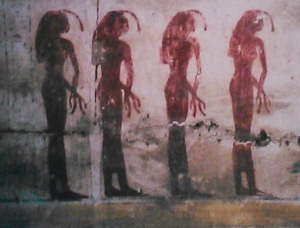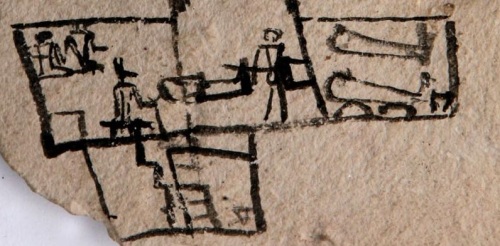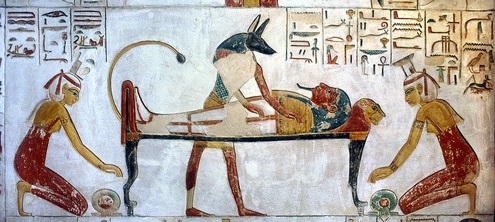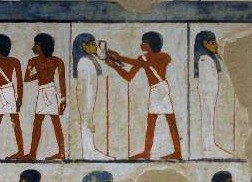We usually think that the decoration from the Egyptian tombs does not change in the whole history of Ancient Egypt. But in fact, there are some images, which appear in some periods and become usual during some time.

Mourner offering the make-up. Detail from the south wall in the tomb of Rekhmire. XVIII Dynasty.
That is the case of a typical Egyptian scene of the professional mourner in some tombs of the New Kingdom: the tomb of Rekhmire (TT 100), the tomb of Sobekhotep (TT 63) or the tomb of Sennefer (TT 96). The mourner appears with no mane of hair kneeling in front of an altar and offering globular vases. According to the inscription in Rekhmire’s tomb, she if offering green make-up for the eyes (Hodel-Hoenes, S., Leben und Tod im Alten Ägypten. Thebanische Privatgräber des Neuen Reiches. Darmstadt, 1991, p. 130).

Offering make-up in the tomb of Sennefer.It is similar to the scene in the tomb of Rekhmire. Gourna. XVIII Dynasty. Photo: www.osirisnet.net
We could think that, if the scene appears now it is becuase it refers to something belonging to the Egyptian funerals of the New Kigndom, but in fact it is not so.
This action happens just after the Opening of the Mouth ceremony; ; a group of Ancient Egypt sacred practices 8And also secret) for giving back the life to the deceased. We have already seen that, according to the documents, it seems that in these ceremony the mourners were shaven just after the official mourning rite. It was the moment of offering the Udjat eye to the mummy and reviving this way the myth of Osiris, in which the god received the Udjat eye as a sign if his final resurrection. And in the rite it happens when the ox (as a sethian victim) has already been sacrificed.
At the end of Ancient Egypt funerals the dead had to receive the Udjat eye. The funeral staff symbolized it shaving the mourners and giving make-up for the eyes. The fact of presenting make-up is already documented in the Pyramid Texts of the Old Kingdom (Pyr. 54b-55; Pyr. 609) and the Coffin Texts of the Middle Kingdom (CT VII, 934; 936) as a gesture which symbolizes “to fit the eye in the face” (Wb, IV, 370, 12).
In many cases the mourners offered green make-up for the left eye and black make-up for the right one. This was a way of representing the whole lunar cycle, and therefore the victory of Horus over Seth. A belief, which was very rooted to Egyptian though from immemorial times. So, to give the make-up at the end of the Opening of the Mouth ceremony would be much older than the XVIII Dynasty.
For some reason, the practice of offering the make-up could be during the XVIII Dynasty represented. As it happens with some other gestures of funerary rites, the artists of the New Kingdom were more aware than before of what happened during the Egyptian funerals. The secret funerary rites of Ancient Egypt, got into the Egyptian art.












